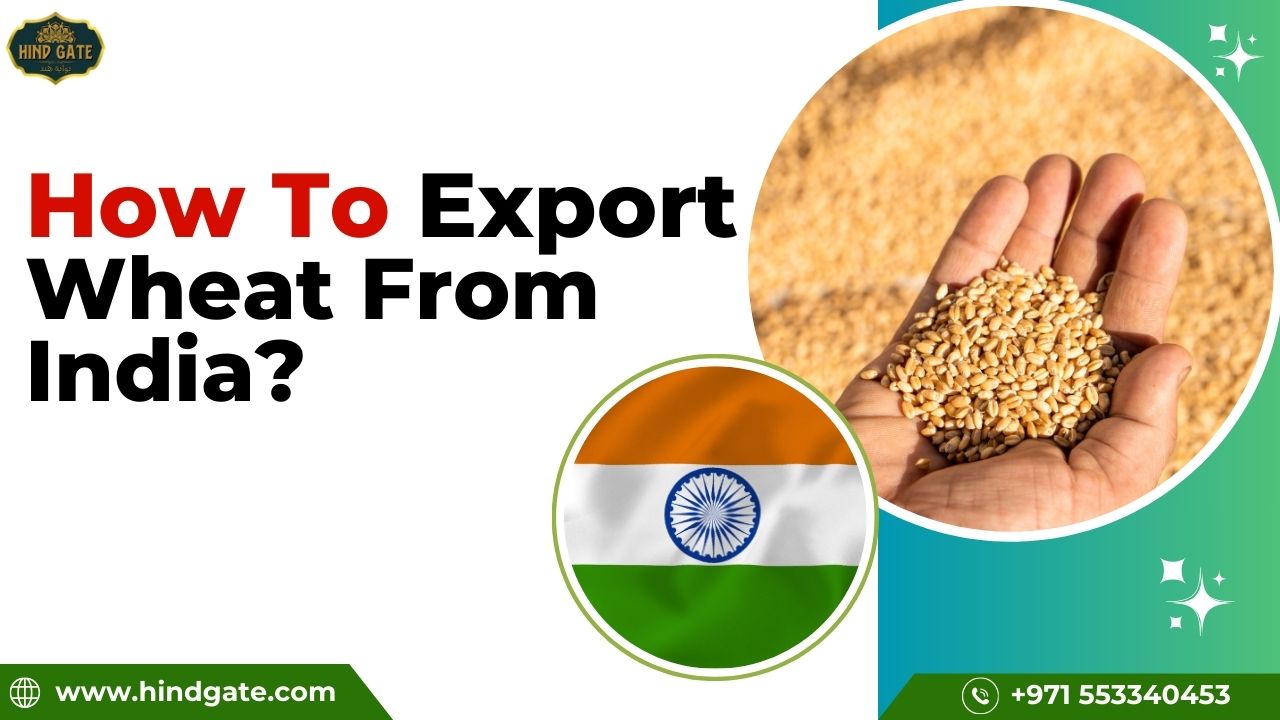
How to Export Wheat From India? A Complete Guide
India has steadily grown into one of the top wheat suppliers in the global market. From premium Sharbati wheat to processed whole wheat flour, Indian farmers and traders have carved a niche in the international food supply chain. Whether you are a new entrepreneur or an established agribusiness, understanding how to export wheat from India is essential to unlock global opportunities.
However, Indian government policies and APEDA regulations support wheat exports and create strong international demand. With India’s strategic advantage in agricultural production, many Indian wheat exporters are successfully tapping into premium markets in the Middle East, Africa, and Southeast Asia.
Why Export Wheat from India?
The global wheat market is consistently expanding due to increasing food consumption, bakery industry growth, and demand for processed flour. Here’s why India has become a strong player:
- High demand for Indian wheat – Premium varieties like Sharbati and Durum are highly sought after in Middle Eastern and European markets.
- Competitive pricing – Indian wheat exporters provide cost advantages without compromising on quality.
- Global wheat imports rising – Countries like Indonesia, UAE, and African nations rely heavily on wheat imports to meet local demand.
Assured quality – Strict grading and certification make Indian wheat quality stand out in global trade.
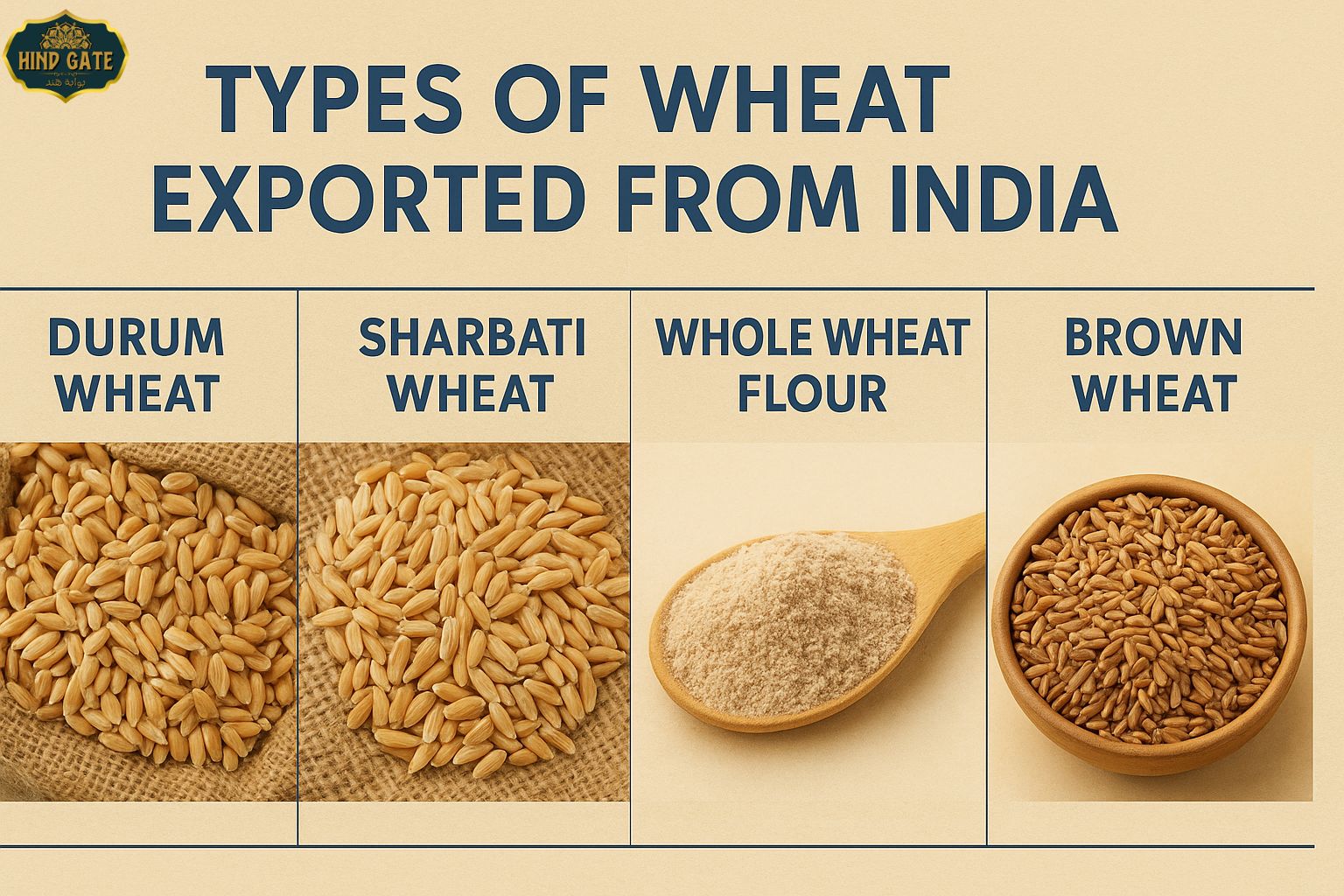
Types of Wheat Exported from India
India exports multiple varieties of wheat and wheat-based products. Here are the most popular categories:
| Type of Wheat | Description | Major Import Markets |
|---|---|---|
| Durum Wheat | Hard wheat ideal for pasta and semolina | Italy, Spain, UAE |
| Sharbati Wheat | Premium wheat with soft texture and rich taste | Middle East, Europe |
| Whole Wheat Flour | Ground and processed for baking | Africa, Southeast Asia |
| Wheat Bran | By-product rich in fiber, used for feed & health products | USA, Canada, UAE |
Indian wheat has earned recognition in world markets for quality and versatility. Similarly, premium agri-products like those covered in our guide on export tea from India show how India dominates multiple food export categories.
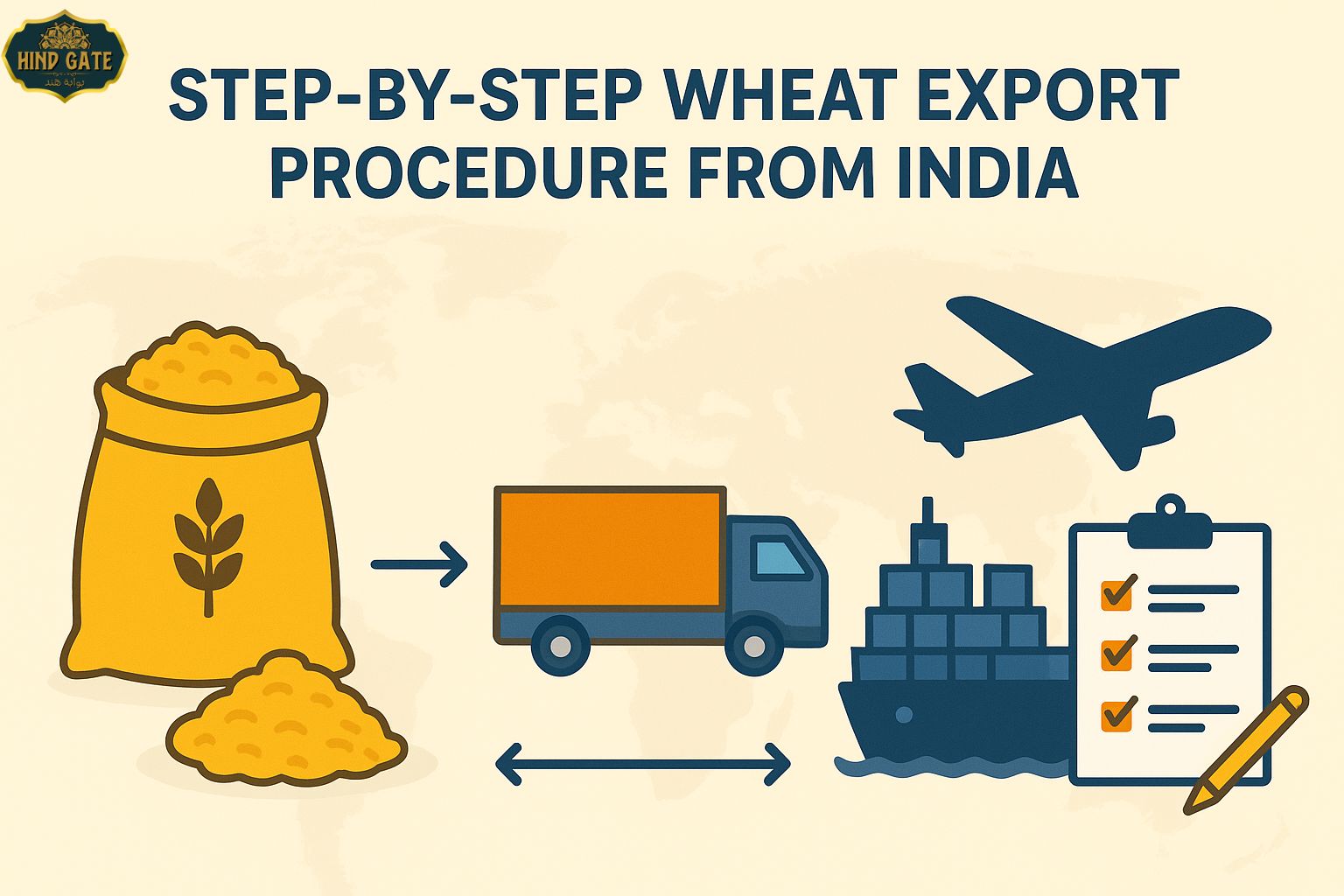
Step-by-Step Wheat Export Procedure from India
Here’s a detailed roadmap for starting a successful wheat export business:
Register Your Business
Set up your company as a proprietorship, partnership, or private limited entity. A registered business structure increases credibility with buyers and is essential for export documentation.
Apply for Import Export Code (IEC)
Issued by the DGFT, IEC is mandatory for any business involved in foreign trade. Without it, customs will not allow shipments.
Register with APEDA
The Agricultural and Processed Food Products Export Development Authority supports exporters with guidance, certification, and global promotion. APEDA registration is compulsory for agri-exports.
Get an FSSAI License
To ensure food safety compliance, exporters must obtain an FSSAI license. Furthermore, this ensures buyers that Indian wheat meets international food safety standards.
Procure Wheat
Partner with reliable farmers or reputed mills. Always verify quality and ensure consistent supply contracts to avoid shortages during high-demand seasons.
Conduct Quality Testing & Grading
Check for grain size, moisture levels, purity, and cleanliness. Accredited labs can issue quality certificates that make your wheat more acceptable to overseas buyers.
Packaging & Labelling
Use durable, export-grade jute or polypropylene bags (25kg, 50kg, or bulk containers). Labels must include product name, origin (India), net weight, batch number, and expiry details.
Find International Buyers
Connect through B2B platforms (Alibaba, IndiaMART, TradeIndia), participate in international food expos, or join trade delegations. Additionally, long-term relationships increase repeat orders.
Arrange Shipment
For bulk orders, sea freight is most cost-effective. For urgent deliveries or small consignments, air freight is preferred. Always work with a reliable freight forwarder or CHA for smooth customs clearance.
Secure Payment
To reduce risk, prefer letters of credit (LCs) or advance telegraphic transfers (TT). For regular buyers, trusted payment methods like bank transfers can be arranged.
Additionally, many exporters follow the same process when exporting spices from India to Dubai, where documentation and compliance are equally critical.
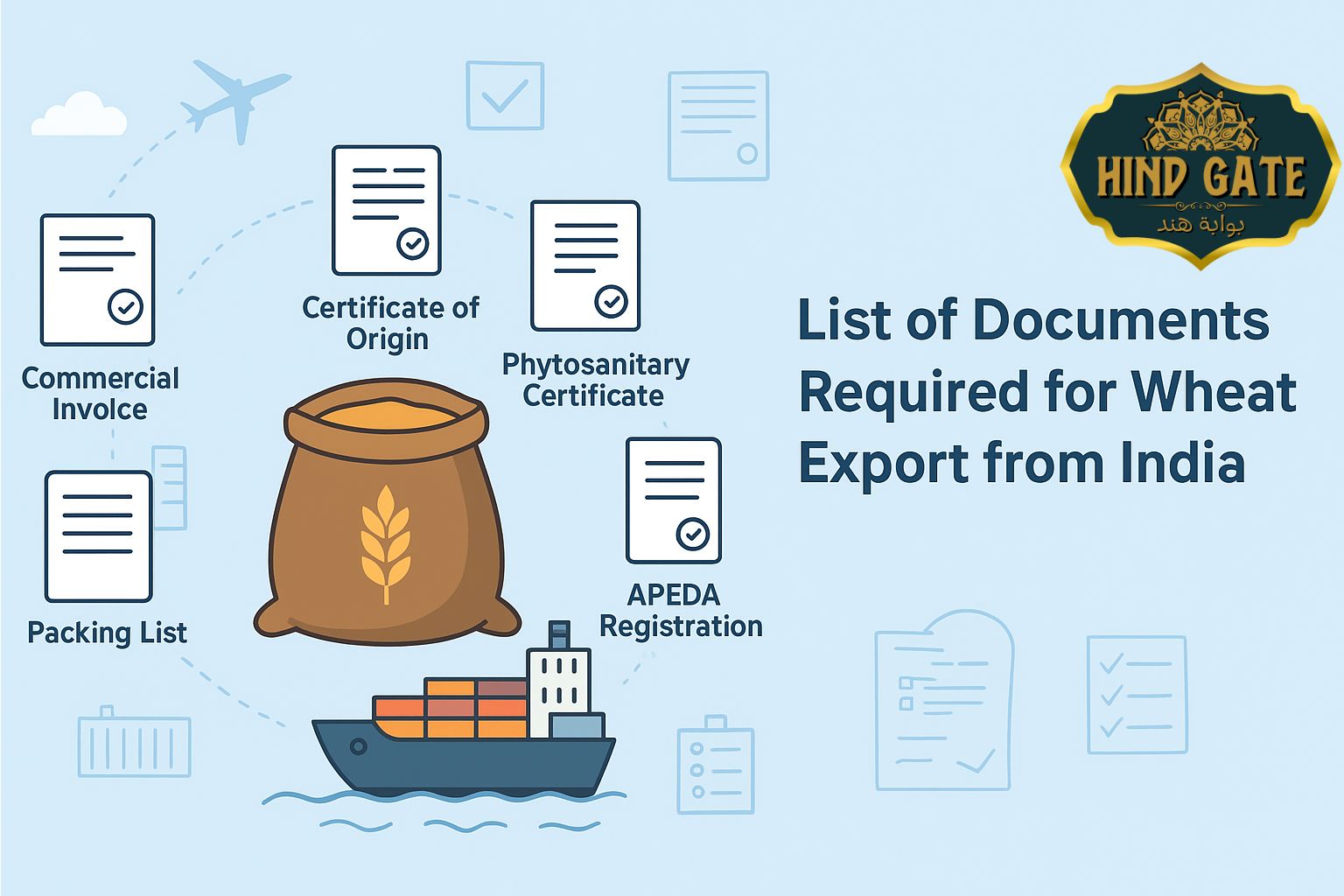
List of Documents Required for Wheat Export from India
For a smooth wheat shipment process, exporters must prepare the following documents to ensure compliance and hassle-free customs clearance:
- Import Export Code (IEC) – Mandatory for all exports from India.
- APEDA Registration Certificate – Required for agri-food exports under APEDA.
- FSSAI License for Wheat – Ensures food safety and quality compliance.
- Commercial Invoice – Provides details of price, buyer, and transaction.
- Packing List – Specifies product details, weight, and packaging type.
- Certificate of Origin (Wheat) – Certifies that the wheat is of Indian origin.
- Phytosanitary Certificate – Confirms product health, pest-free condition, and safety.
- Bill of Lading / Airway Bill – Essential shipping and transport document.
- Insurance Policy – Protects against shipment risks and losses.
- Quality Certificate – Optional, but builds buyer trust by validating wheat standards.
- Letter of Credit (LC) / Payment Terms – Financial document ensuring secured payment.
- Export Declaration Form (EDF) – Required by customs for foreign exchange compliance.
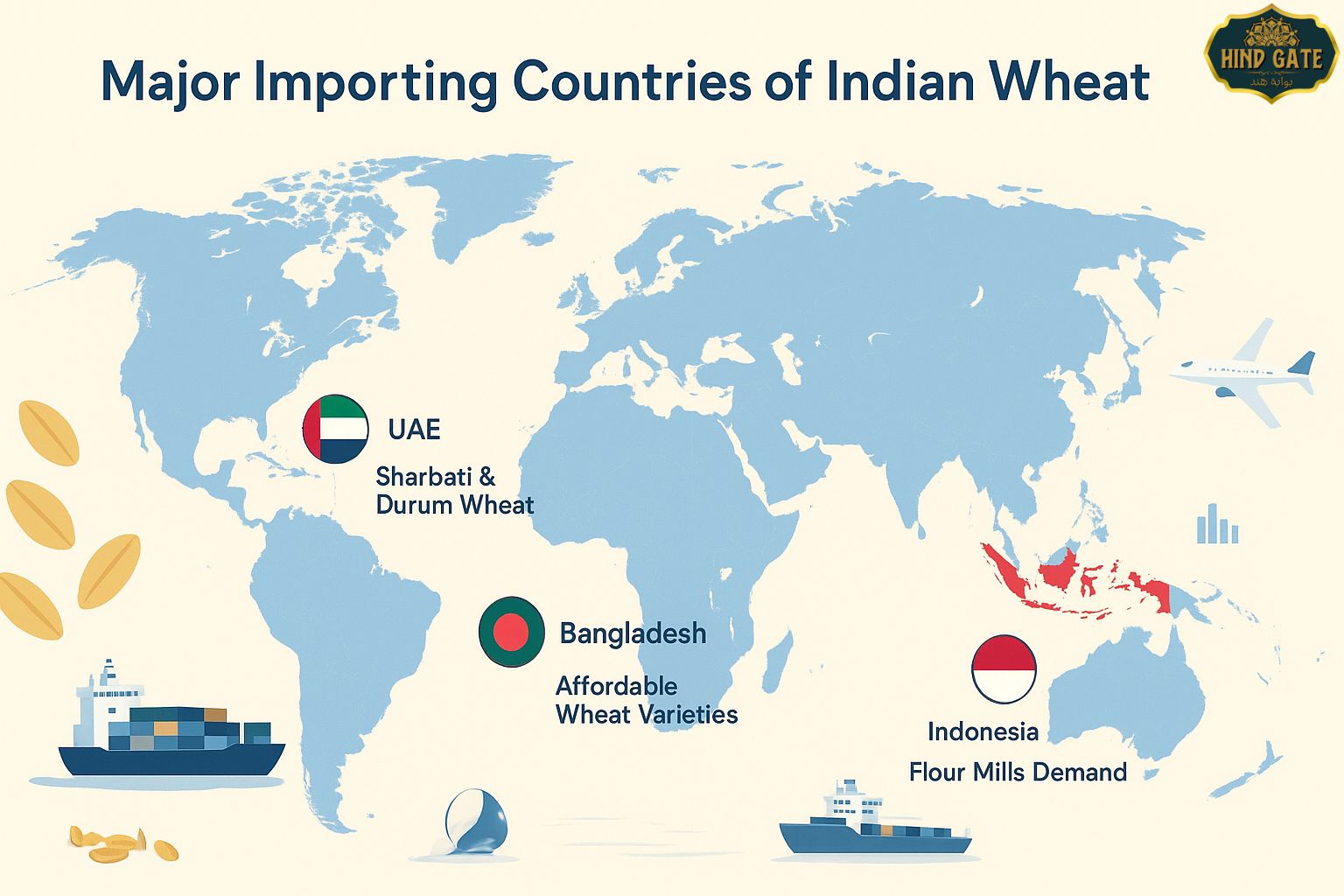
Major Importing Countries of Indian Wheat
The demand for Indian wheat is strong across multiple regions. Here are the top importers:
- UAE – Strong demand for Sharbati and Durum wheat.
- Bangladesh – Consistent demand for affordable wheat varieties.
- Indonesia – High volume imports for flour mills.
- Egypt – Wheat for bakery and food processing industries.
- Europe (Italy, Spain) – Preference for durum wheat export India.
By diversifying into top 10 rice importers in Dubai, exporters can target multiple food categories and boost trade opportunities.
Logistics & Shipping of Wheat from India
Efficient logistics are crucial for timely delivery and maintaining product quality.
- Sea Freight Wheat Export – Cost-effective for bulk shipments.
- Air Cargo Wheat Export – Faster, suitable for premium consignments.
- Wheat Packaging Export Standards – 25kg, 50kg jute/poly bags, moisture-proof.
- Bulk Wheat Shipment India – Containers or break-bulk for large orders.
Logistics & Shipping of Wheat from India
Efficient logistics are crucial for timely delivery and maintaining product quality.
- Sea Freight Wheat Export – Cost-effective for bulk shipments.
- Air Cargo Wheat Export – Faster, suitable for premium consignments.
- Wheat Packaging Export Standards – 25kg, 50kg jute/poly bags, moisture-proof.
- Bulk Wheat Shipment India – Containers or break-bulk for large orders.
Challenges in wheat export and how to overcome them
Like any international business, exporting wheat has challenges.
- Wheat export challenges – Price fluctuations, weather impact, and competition.
- Wheat trade restrictions India – Occasional government bans on wheat exports.
- Customs clearance wheat export – Delays due to incomplete paperwork.
Solution: Work with experienced partners, diversify markets, and ensure proper certifications. Many exporters face similar issues in other crops such as export pulses from India, but preparation helps reduce risks.

Why Choose Hind Gate General Trading LLC for Wheat Export?
Hind Gate General Trading LLC is a trusted partner in global food exports. Based in Dubai, the company bridges the gap between Indian farmers and international buyers with:
- Strong sourcing network from certified Indian wheat suppliers.
- Expertise in APEDA registration and documentation support.
- Reliable logistics via sea and air freight channels.
- Established buyer network in UAE, Africa, and Asia.
Furthermore, Hind Gate is a reputable wheat exporter UAE that ensures compliance, quality, and profitability.
Conclusion
The opportunity to export wheat from India is enormous, with steady global wheat imports and rising demand across continents. From durum wheat export India to whole wheat flour and bran, Indian farmers and exporters have much to gain.
By following the right wheat export procedure India, securing necessary documents, and partnering with experts, you can successfully start wheat export business and meet Indian wheat global demand.
If you are planning to diversify further, consider other agri-opportunities such as export milk powder from India, which has shown strong growth in the UAE.



